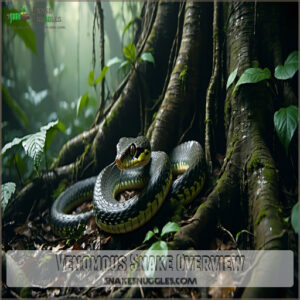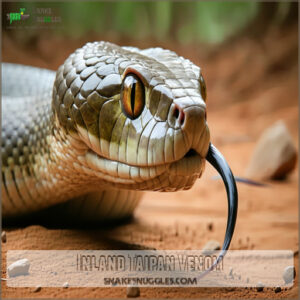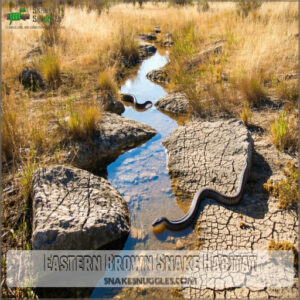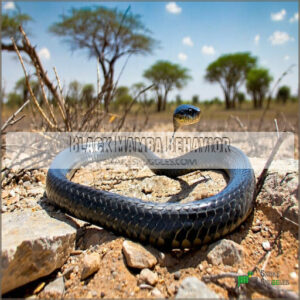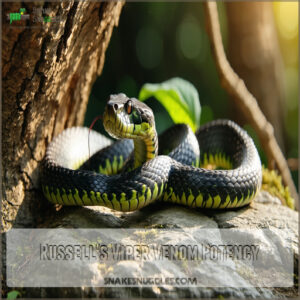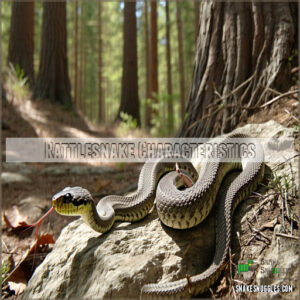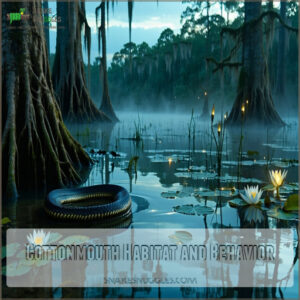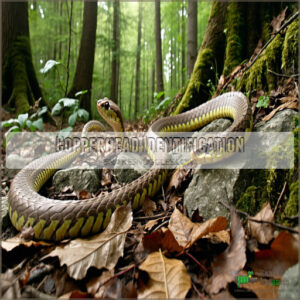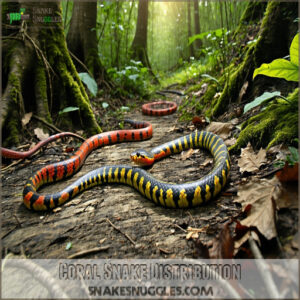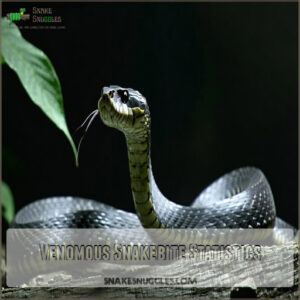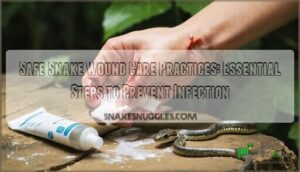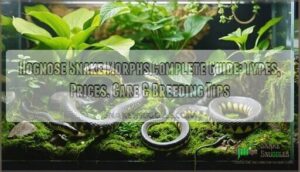This site is supported by our readers. We may earn a commission, at no cost to you, if you purchase through links.
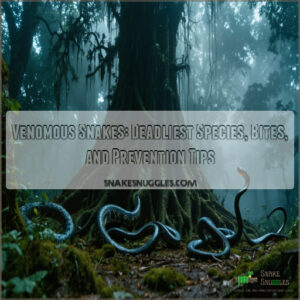 Venomous snakes are fascinating yet formidable creatures, using specialized fangs to deliver venom—a mix of proteins that can immobilize prey and, yes, harm humans.
Venomous snakes are fascinating yet formidable creatures, using specialized fangs to deliver venom—a mix of proteins that can immobilize prey and, yes, harm humans.
Found worldwide, species like the inland taipan, black mamba, and king cobra are among the most dangerous.
In the U.S., you’ll encounter rattlesnakes, copperheads, and coral snakes.
Snakebites, though rare, can cause serious symptoms like pain, swelling, or even organ damage.
The good news? Antivenoms save countless lives annually.
To stay safe, learn to identify local species, wear protective clothing, and avoid rocky or grassy areas where snakes may hide.
There’s more to explore about snake safety!
Table Of Contents
- Key Takeaways
- Venomous Snake Overview
- Deadly Venomous Snakes
- US Venomous Snake Species
- Snakebite Prevention Methods
- Venomous Snakebite Statistics
- Frequently Asked Questions (FAQs)
- What is the top 10 most venomous snake?
- What is the 4 most venomous snake?
- What is the #1 poisonous snake?
- What’s the difference between a venomous snake and a poisonous snake?
- Are snakes venomous?
- Which snake has the most lethal venom?
- How much venom is in a snake?
- How do Snakes get venom?
- What are the 4 most poisonous snakes?
- What is the 1 deadliest snake?
- Conclusion
Key Takeaways
- Learn to identify venomous snakes by their triangular heads, vertical pupils, and distinct patterns to stay safe outdoors.
- Wear snake-proof boots and protective clothing to minimize the risk of snakebites in snake-prone areas.
- If bitten, seek immediate medical attention and use antivenom to neutralize the venom and increase survival chances.
- Venomous snakes play critical roles in ecosystems, but awareness and prevention are key to safely coexisting with them.
Venomous Snake Overview
You might think venomous snakes are rare, but about 600 species worldwide can deliver venom potent enough to harm humans.
Their venom isn’t just dangerous—it’s a specialized tool evolved for hunting prey and defending against threats.
Global Species Distribution
Venomous snakes are found across the globe, thriving in diverse habitats like deserts, rainforests, and oceans.
Their global species distribution varies by climate adaptation, from frozen tundra to steamy biodiversity hotspots.
You’ll find the highest species density in tropical regions, where range expansion is common due to warming climates.
Every venomous snake habitat holds clues about their fascinating survival strategies.
Venom Composition and Effects
Snake venom isn’t just dangerous—it’s a chemical marvel shaped by evolution. Each snake species packs a unique mix of venom components, targeting specific prey or defense.
- Neurotoxic effects: Paralyzes by attacking nerves.
- Hemotoxic effects: Wreaks havoc on blood, clotting, and vessels.
- Cytotoxic effects: Destroys cells and tissue.
Venom toxicity depends on snake venom composition and delivery. Precision weaponry adapted by nature.
Snakebite Statistics and Impact
Every year, venomous snake bites leave a chilling global impact—5.4 million bites, with 138,000 snakebite fatalities and countless injuries.
Mortality factors like weak healthcare worsen outcomes, especially in rural areas of Africa, Asia, and Latin America.
Snakebite statistics reveal alarming injury patterns, including amputations and paralysis.
Fatality rates spike when antivenom access is limited, making prevention and awareness essential for safety.
The public health issue of snakebites is a significant concern that affects many communities worldwide.
Antivenom Treatment and Importance
When facing venomous snakes, antivenom is the only lifesaver for severe snake bite symptoms.
It neutralizes snake venom fast but needs proper administration.
CSL Ltd. is the sole Australian antivenom manufacturer.
Here’s a glimpse:
- Creation: Derived from venom-injected animal antibodies.
- Usage: Immediate treatment post-bite.
- Types: Species-specific or polyvalent.
- Risks: Allergic reactions possible.
- Outcome: Speeds up recovery, saving lives.
Deadly Venomous Snakes
You’ll find the world’s deadliest venomous snakes in diverse regions, from Australian deserts to African savannas.
These species, like the Inland Taipan and Black Mamba, possess venom so potent it can kill within hours without treatment.
Inland Taipan Venom
The inland taipan, the world’s most venomous snake, delivers a toxin brew so potent it can kill over 100 humans with one bite.
Its venom includes neurotoxins and myotoxins, causing paralysis and tissue damage.
Antivenom is essential for survival, though recovery is slow.
Check out this breakdown:
| Feature | Description |
|---|---|
| LD50 | 0.025 mg/kg (extremely lethal) |
| Venom Type | Neurotoxins, hemotoxins, more |
| Threat Range | Strikes with pinpoint accuracy |
| Treatment Need | Immediate antivenom necessary |
The table provides a detailed overview of the inland taipan’s venom, including its lethal effects and the need for immediate medical treatment.
Eastern Brown Snake Habitat
The Eastern Brown Snake thrives in diverse habitats like grasslands, forest floors, and rocky outcrops across Australia.
This swift and defensive species hunts prey, including house mice, near human settlements.
Preferring desert ecosystems and snake dens over dense forests, it’s solitary and diurnal.
Its adaptability makes it a key player in snake ecology among venomous Australian snakes.
Black Mamba Behavior
The Black Mamba, known as one of the deadliest snakes, is a master of hunting tactics and speed, reaching up to 12 mph. These venomous snakes inhabit sub-Saharan Africa, favoring rocky, dry areas.
For more fascinating insights, explore these interesting black mamba facts.
Their venom delivery is swift, often paired with aggressive posturing when threatened. However, they are shy and prefer fleeing.
- Shy, prefers fleeing
- Strikes multiple times
- Targets nervous systems
- Longest African snake
- Threatens with expanded neck
Russell’s Viper Venom Potency
How dangerous is Russell’s viper?
Its venom packs a punch with high snake venom toxicity, mixing hematoxin effects and neurotoxic components.
The LD50 comparison shows its potency rivals top venomous snakes.
Prey specificity drives its venom’s design, but it’s deadly to humans too.
Antivenom efficacy saves lives, though untreated bites risk severe damage, including kidney failure and prolonged pain, which is a result of the venom’s neurotoxic components.
US Venomous Snake Species
You’ll find a fascinating mix of venomous snakes across the United States, each with unique traits and behaviors.
From rattlesnakes to coral snakes, these species play an important role in their ecosystems but can pose risks if not approached with caution.
Rattlesnake Characteristics
How do rattlesnakes warn you? Their iconic snake rattle is a clear “stay back” signal.
These venomous snakes thrive in diverse rattlesnake habitats like deserts, forests, and grasslands, blending with distinct snake patterns.
Species like the Timber Rattlesnake and Mojave Rattlesnake showcase powerful venom delivery. Rattlesnake behavior is defensive, not aggressive—most bites occur when provoked or accidentally stepped on.
Cottonmouth Habitat and Behavior
Cottonmouths thrive in wetland ecology, embracing a semiaquatic lifestyle with sharp aquatic adaptations.
You’ll find these venomous snakes lounging near rivers, swamps, or lakes.
Their snake behavior includes basking on logs or coiled along shorelines.
Watch for migrations during flooding, as Northern Cottonmouths shift habitats.
With a potent venom delivery, they defend themselves fiercely when threatened, showcasing their ability to adapt in a semiaquatic lifestyle.
Copperhead Identification
Spotting copperheads is easier when you know what to look for.
Examine the Snake Head Shape—triangle-shaped with vertical pupils—and Snake Scale Patterns, featuring distinctive hourglass bands.
Check Tail Coloration too; juveniles have yellow-tipped tails.
Copperheads thrive in forests, rocky areas, and wetlands, forming their Copperhead Habitat.
Understanding the copperhead snake characteristics is essential for identification.
Use the table below for quick snake identification tips.
| Feature | Eastern Copperhead Details | Importance | Risk Indicator |
|---|---|---|---|
| Head Shape | Triangular | Identifies venomous | High |
| Scale Patterns | Hourglass bands | Distinctive marking | Medium |
| Tail Coloration | Yellow in juveniles | Age indicator | Medium |
| Habitat | Forests, wetlands, rocky areas | Common location | High |
Coral Snake Distribution
Copperheads might dominate conversations, but coral snakes have their own secretive charm.
These venomous snakes, found in North America, prefer wooded areas, marshes, and rocky habitats.
Their vibrant red, yellow, and black bands make them hard to miss.
Habitat loss and snake migration may impact snake distribution, isolating species like the Arizona Coral Snake around deserts or coral reefs.
Snakebite Prevention Methods
If you want to avoid snakebites, it’s important to stay alert and take simple precautions.
From wearing the right gear to knowing where snakes are most likely to hide, these steps can substantially reduce your risk.
Snake Identification Techniques
Knowing snake patterns and head shapes can save your skin—literally.
Venomous snake species often have triangular heads, vertical pupils, and distinct color bands.
Scale inspection helps too; smooth scales are common on non-venomous types.
Familiarize yourself with venom signs like rattles or aggression in certain species.
Spotting these clues keeps you safe from dangerous types of venomous snakes.
Understanding the venomous snake identification process is essential for effective prevention and safety measures.
Protective Clothing and Gear
For extra protection when venturing into snake-prone areas, gear up with snake proof boots and protective suits.
Safety gloves and venom shields are essential for handling brush or debris.
Defensive gear isn’t overkill—it’s smart snake safety!
This practical snake bite prevention approach minimizes risks, giving you peace of mind when exploring areas where venomous snakes might be lurking.
When exploring outdoors, wearing snake proof boots can substantially reduce the risk of snakebites.
Prevention of Snakebites
Snakebite prevention starts with staying aware, stick to safe hiking trails, and watch your step—snakes blend into their surroundings.
Wear boots and long pants for added protection, consider purchasing durable snake boots for increased protection in high-risk areas.
Learn snakebite prevention strategies like recognizing warning signs, such as a hissing sound or rattling tail.
If bitten, apply first aid quickly and seek emergency response immediately, snake safety saves lives.
Snake Conservation Efforts
Snake conservation matters for preserving our ecosystems and protecting endangered species.
Habitat preservation and wildlife protection keep venomous snakes, like rattlers and cobras, in their natural homes, reducing human conflict.
Supporting snake research and innovative conservation methods helps us understand their role in biodiversity.
Every species, even the misunderstood ones, deserves a chance to thrive—wildlife needs balance, not fear, and this is crucial for maintaining ecosystems.
Venomous Snakebite Statistics
Every year, millions of people are bitten by snakes, with venomous species responsible for nearly half of these cases.
Understanding where these bites happen most and their outcomes can help you see the real risks and importance of quick medical care.
Annual Snakebite Cases
Snakebite trends show millions bitten yearly, but numbers vary by region.
India leads with 2.8 million cases, while Africa faces over a million.
Snakebite victims often encounter delayed medical response, increasing fatality rates.
| Region | Annual Bites | Fatalities |
|---|---|---|
| India | 2.8 million | 46,900 |
| Sub-Saharan Africa | 1 million | 7-20,000 |
Deaths Due to Venomous Snakes
Snakebite fatalities remain a striking issue, with 63,400 deaths globally in 2019.
Medical response delays, human error, and lack of antivenom fuel mortality trends, especially in rural regions.
The deadliest snakes, like the saw-scaled viper, highlight the danger of snake venom toxicity.
Fatal bite rates climb when healthcare access is limited or envenoming goes untreated.
Understanding the most venomous snake species is essential for developing effective prevention and treatment strategies.
| Cause | Impact | Region |
|---|---|---|
| Delay in treatment | Increased deaths | Rural Asia & Africa |
| Human error | Mismanagement | Global |
| No antivenom access | Higher fatalities | Developing nations |
| Aggressive species | Fatal bite rates | India |
| Lack of awareness | More injuries | Low-income countries |
Most Venomous Snakes Worldwide
Some of the most venomous snakes worldwide include the inland taipan, black mamba, and eastern brown snake.
Their toxins, targeting nerves, blood, and muscles, highlight nature’s potency and venom resistance’s rarity among prey.
| Snake | Region | Venom Type | Effects | Toxicity Rank |
|---|---|---|---|---|
| Inland Taipan | Australia | Neurotoxins | Paralysis, death | #1 |
| Black Mamba | Africa | Neurotoxins | Rapid death | #2 |
| Eastern Brown | Australia | Hemotoxins | Coagulation issues | #3 |
| Saw-Scaled Viper | Asia, Africa | Hemotoxins | Severe bleeding | #4 |
| Banded Krait | Asia | Neurotoxins | Paralysis | #5 |
Venomous Snakes Responsible for Deaths
The deadliest snakes aren’t just the most venomous—they’re the ones humans meet the most.
The Big Four snakes in India—the Russell’s Viper, Saw-Scaled Viper, Indian Cobra, and Common Krait—cause thousands of fatal bite cases annually due to their venom toxicity and widespread presence.
Limited medical access boosts snakebite fatalities.
Here’s how snake venom impacts survival:
| Snake | Region | Bite Impact | Mortality Rates |
|---|---|---|---|
| Russell’s Viper | South Asia | Blood clotting, kidney failure | High without antivenom |
| Saw-Scaled Viper | India, Africa | Organ damage | Highest snake bite mortality |
| Indian Cobra | South Asia | Neurotoxic-anesthetic venom | Severe fatalities |
| Common Krait | South Asia | Paralysis, respiratory failure | Very high at night |
Frequently Asked Questions (FAQs)
What is the top 10 most venomous snake?
Think of these snakes like nature’s tiny assassins.
The Inland Taipan tops the list, followed by Dubois’ Sea Snake, Eastern Brown Snake, Yellow-Bellied Sea Snake, Central Ranges Taipan, Coastal Taipan, Black Mamba, Belcher’s Sea Snake, Many-Banded Krait, and the Boomslang.
What is the 4 most venomous snake?
You’ve got the Inland Taipan, Dubois’ Sea Snake, Eastern Brown Snake, and Coastal Taipan leading the venom charts.
Their venoms act fast, targeting nerves or blood, making them the most potent threats globally.
What is the #1 poisonous snake?
The Inland Taipan, also called the "fierce snake," holds the title for most toxic venom.
Its venom can kill multiple humans in one bite.
Thankfully, it’s shy and rarely encountered outside its native Australian desert.
What’s the difference between a venomous snake and a poisonous snake?
The difference boils down to delivery.
A venomous snake injects toxins via fangs, like a syringe.
A poisonous snake, on the other hand, harms when touched or eaten—so you’re the one making contact.
Are snakes venomous?
About 600 of the world’s 3,700 snake species are venomous, using venom to catch prey or defend themselves.
Not all snakes pose a threat to you, but staying alert is always a smart move.
Which snake has the most lethal venom?
The snake with the most lethal venom is the Inland Taipan, often called the "fierce snake."
Its venom is so potent it can kill humans within hours, yet it rarely bites due to its shy nature.
How much venom is in a snake?
You’d expect all snakes to carry buckets of venom, right?
Actually, venom amounts vary.
Some deliver tiny drops, while rattlesnakes or cobras can inject enough to kill several humans, depending on the species and bite.
How do Snakes get venom?
Snakes produce venom in specialized glands, like tiny chemistry labs, located behind their eyes.
These glands create proteins and enzymes that paralyze prey or deter threats, delivering the venom through hollow fangs during a bite.
What are the 4 most poisonous snakes?
Picture hiking in India and encountering a Russell’s viper—it’s one of the "Big Four," alongside the Indian cobra, saw-scaled viper, and common krait.
These snakes’ venom causes thousands of deaths annually.
Stay alert!
What is the 1 deadliest snake?
The inland taipan, nicknamed the "fierce snake," holds the title of the world’s deadliest.
Its venom is so potent, a single bite could kill 100 men, but it rarely encounters humans in its remote habitat.
Conclusion
Did you know venomous snakes cause over 100,000 deaths worldwide each year?
While these creatures are essential to ecosystems, their venom poses serious risks.
Understanding the behaviors and habitats of venomous snakes, like rattlesnakes and king cobras, can help you stay safe.
Wear protective clothing outdoors, avoid snake-prone areas, and learn to identify local species.
Remember, antivenoms save lives, so swift medical attention is necessary after a bite.
Respect these powerful predators while prioritizing safety.
- https://www.reptilegardens.com/animals/snakes/venomous
- https://en.wikipedia.org/wiki/Venomous_snake
- https://www.britannica.com/list/9-of-the-worlds-deadliest-snakes
- https://www.virginiaherpetologicalsociety.com/reptiles/snakes/index.html
- https://video.vt.edu/media/VMN+CE+WebinarA+Diversity+and+Natural+History+of+Virginia%27s+Snakes/1_fk7zqyt7

